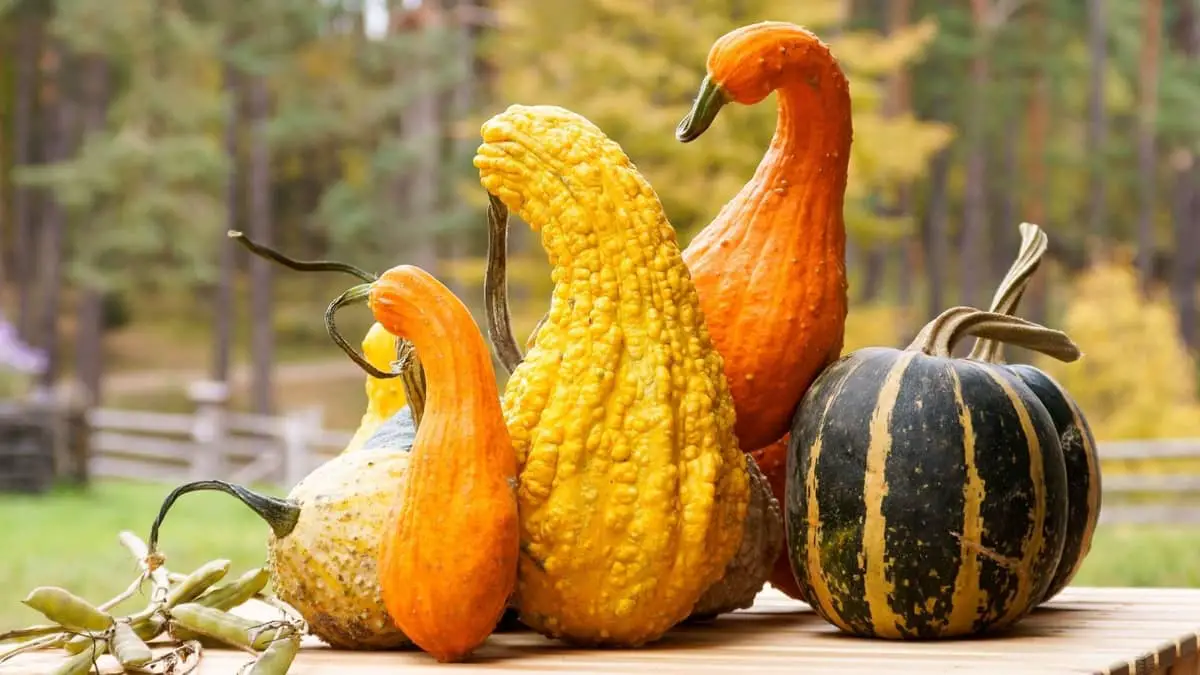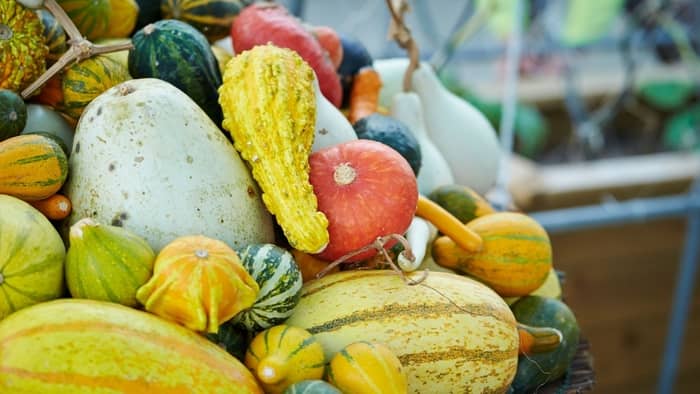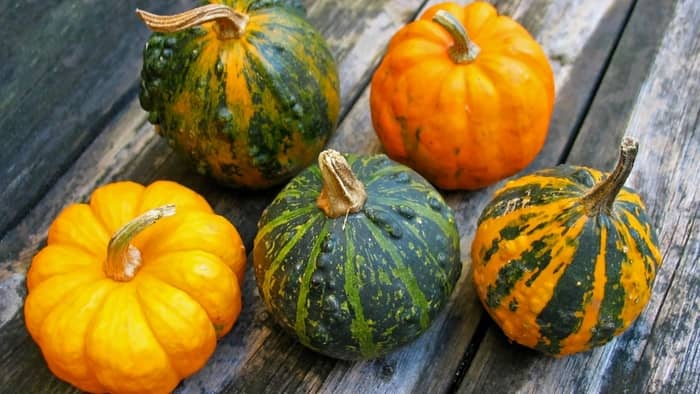Last Updated on January 9, 2022 by Griselda M.
One step at the farmer’s market during fall, and you’re mesmerized by the different types of gourds you encounter. The funny shapes, textures, and sizes make them seem like artificial ornaments. You can grow many of these amusing vegetables in your garden and use them as decoration, as food, or as bathroom supplies – yes, loofah is a type of gourd!
Since many of them resemble tiny pumpkins, we always find them as decor at pumpkin patches. So are gourds pumpkins or are pumpkins gourd? Let’s see all the different types and varieties.
What Are Gourds?
Gourds are one of the first domesticated plants that found their use in the everyday life of ancient people. The conveniently shaped grouds were dried and used as drinking cups for storage and early days showerheads.
Grouds originated in Africa in the late 12,000 BC and were later brought to Europe, Asia, and North America. The numerous varieties and types are overwhelming. The term gourd is often used as a way to describe any plant member of the Cucurbitaceae family.
The gourds we commonly encounter are 2 genera from the Cucurbitaceae family.
- Lagenaria gourds are a bottle-shaped variety. They have thin, smooth skin, large leaves, and white flowers. When dry, they make great kitchen accessories or birdhouses.
- Cucurbita grouds are the fun, spiky, multicolored types. They have thicker skin and yellow flowers. Squashes, pumpkins, and other edible grouds fall under the Cucurbita genus.
Types of Gourds
Some of the ordinary gourds are edible; some are strictly ornamental. And we’re sure that you’ll be surprised by some of the types. Read along to clear up the confusion.
Ornamental and edible gourds (Cucurbita pepo)
Although referred to as an ornamental group of gourds, the Cucurbita pepo is relative to cucumbers, courgettes, and pumpkins. They grow on a vine that spreads out for 10 to 15 feet. The most popular Cucurbita pepo gourd are the common large pumpkin, zucchini, acorn squash, baby boo, and spaghetti squash.
Bottle gourds (Lagenaria siceraria)
The bottle gourds are the most useful kind of gourds through time. When young, they’re tender and edible. But everyone grows them for their hard shell which makes them perfect for yard decor. So while we no longer need gourds as cups, they make perfect birdhouses for your garden visitors.
Bottle gourds also grow on vines and come in many colors. Speckled swan, apple gourd, and calabash fall under this category.
Sponge gourds (Luffa aegyptiaca)
Were you aware you can grow your own bathing sponges in your garden? The sponge gourd is a close relative to cucumber, so their shape is similar. They thrive on vines, and you can eat the young fruit. The mature dried fruit is full of fiber, and you can cut it out to make sponges.
Chinese okra and Lufa are among the popular sponge gourds.
Snake gourds (Trichosanthes cucumerina)
Snake gourds are the weirdest yet impressive gourds. They have impressive white flowers that open only at night and get pollinated by moths. The inside includes watermelon-like seeds and watery flesh.
They’re tender and edible when young but not very tasty. As the snake gourds mature, their shell becomes hard, and you can use them in DIYs. The soft inside of a mature snake gourd is red and edible.
Read more about Squash Growing Tips: How Far Apart to Plant Squash .
How To Plant Different Gourd Varieties?
The easiest way to grow a gourd you like is to buy it and let it dry. Then, pick the seeds and sow them the following year. Gourds are best planted from seeds after the last frost date in spring. If you’re hesitant, you can start them inside a few weeks earlier and transplant them as soon as the weather is right.
Plant the seeds in sets of 4 pieces, 1 to 2 inches under the ground’s surface. Leave 5 feet distance between each set of seeds and 8 feet between the rows.
Gourds are aggressive growers and love to climb. Therefore, you need to provide a frame or trellis to let the plant rise and let the gourd grow off the ground. This can easily be built from PVC pipes.
If you’re feeling more crafty, you can shape the snake and loofa gourds. The young and tender fruit can grow around a post ending in an interestingly shaped gourd.
Are gourds easy to grow?
Gourds are low maintenance and require minimal attention. You can work in some slow-release fertilizer into the soil before planting. During summer, the gourds need more frequent watering.
These plants are aggressive growers, so you must watch their development. They can overwhelm each other and other nearby vegetables.
Which Gourds Types Are Edible?
When planting gourd for food, you must be careful with the choice. There are hundreds of varieties, and many of them are edible. However, some cause adverse reactions like diarrhea, nausea, and vomiting.
To play it safe, go for the commonly used gourds like calabash, butternut squash, acorn squash, watermelon, standard large pumpkin, or bitter melon.
How To Dry Different Types Of Gourds?
Preserving inedible gourds is easy but demands a little more time.
Harvest the gourds when they’re fully mature. This is when the stem is completely dry. Cut by leaving 2 inches of the stem on the gourd. Wash and dry thoroughly, then wipe each gourd with mild disinfectant or alcohol.
Pick a dark warm spot with good air circulation. Put the gourds on a few sheets of paper and let them dry. Check regularly and change the paper as it becomes damp. The gourds are dry when you can hear the seeds inside when shaking.
Cover the dried gourd with wax or polishing spray.
Final Say: Common Types Of Gourds
Gourds are members of the Cucurbita family and can be edible or strictly ornamental. Their colors, shape, and texture are fascinating. Gourds are low maintenance and great for beginner gardeners.
Before deciding on which type to plant, get informed about their use. The hard-shelled types like bottle gourd can serve as great decor around the house. The loofah gourd is not only intriguing but valuable too; you can even produce your own sponges. Other edible gourds like butternut squash are an excellent source of fiber and vitamins.
Share this article with your friends and pick gourd seeds for the spring planting!
Mary is a passionate gardener who loves spending her days getting her hands dirty and nurturing her plants. She‘s an avid reader of gardening magazines and is always looking for new ways to make her garden thrive. When not outside tending to her plants, Mary can be found inside reading up on the latest gardening trends, comparing notes with fellow gardeners, and finding the perfect pottery planter for her next planting project.




